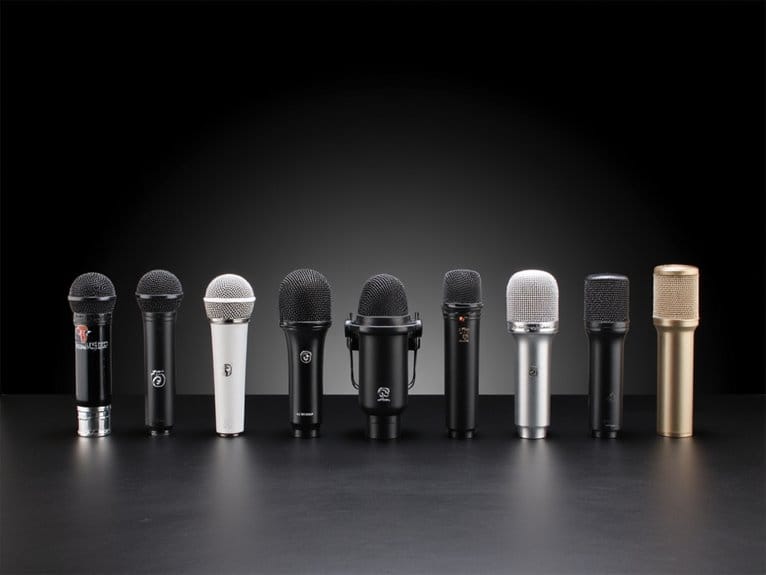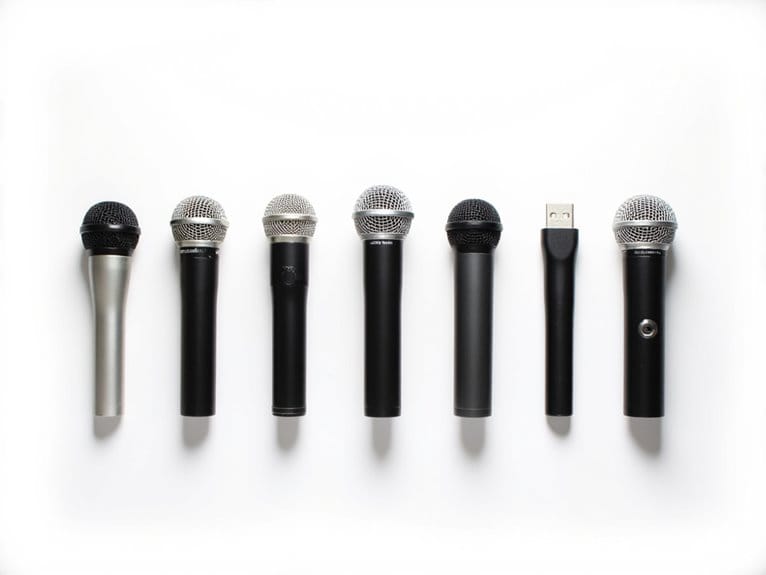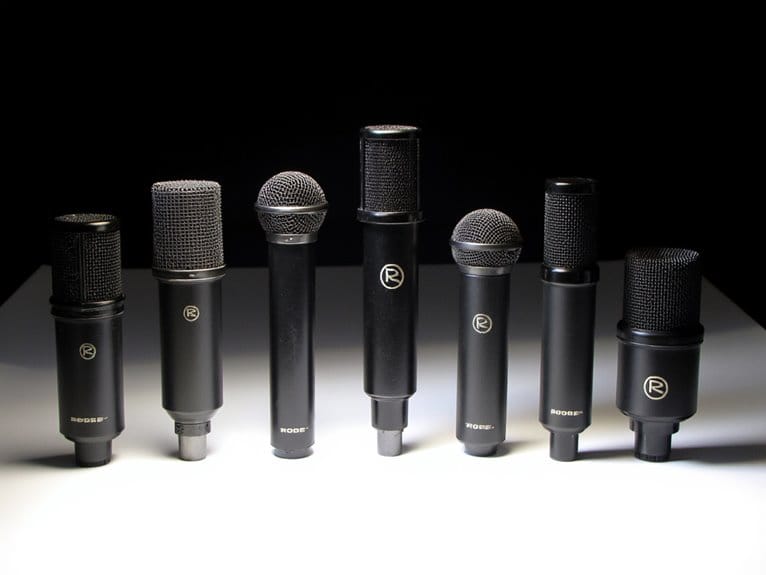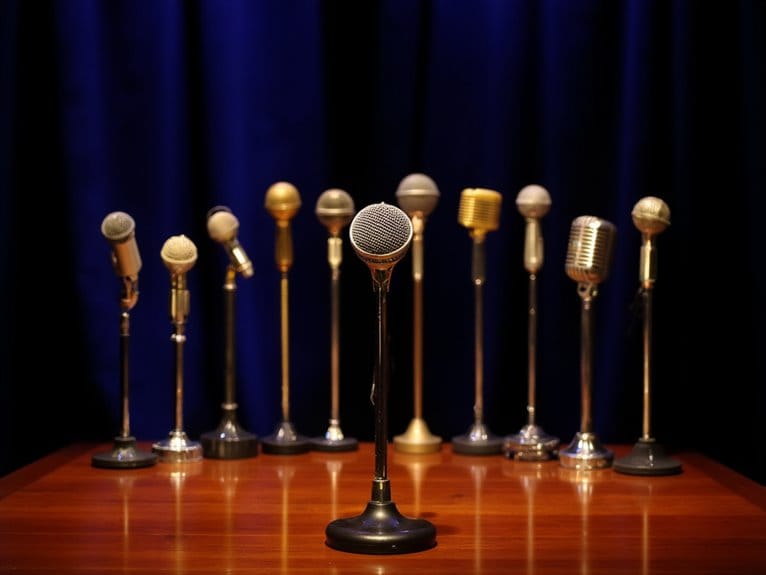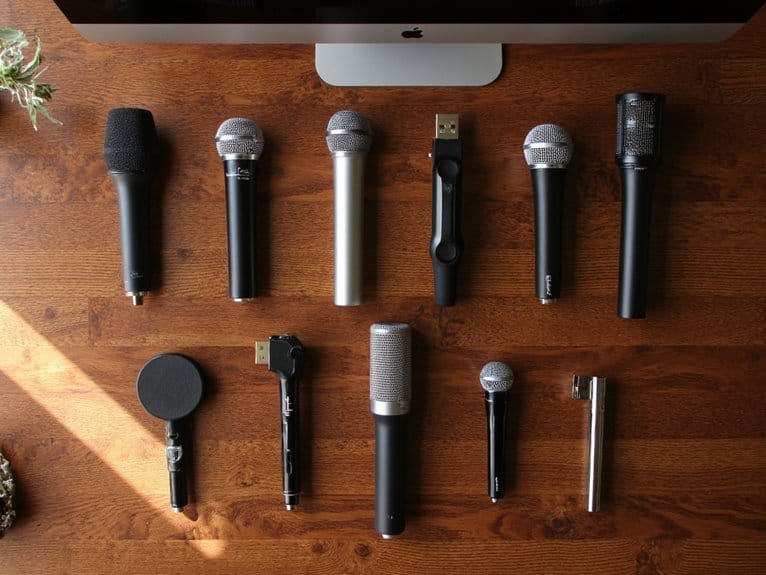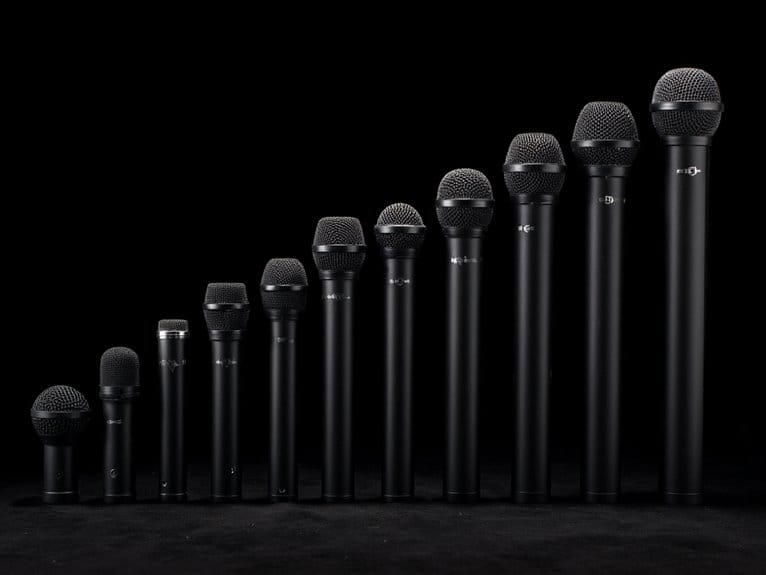10 Best USB Mics of 2025 for Crystal-Clear Audio Recording
I’ve tested dozens of USB microphones this year, and the top performers for crystal-clear audio consistently feature dual USB/XLR connectivity like the FIFINE AM8T and MAONO PD300XT, which offer professional growth paths from streaming to podcasting. The RØDE PodMic USB and Shure MV6 excel with built-in DSP processing and real-time noise reduction, while models like the FIFINE K688 deliver broadcast-quality sound with cardioid patterns that effectively isolate vocals from background interference, ensuring your recordings maintain exceptional clarity across various applications.
We are supported by our audience. When you purchase through links on our site, we may earn an affiliate commission, at no extra cost for you. Learn more.
Notable Insights
- USB microphones with 192kHz/24bit sampling rates and 80+ dB signal-to-noise ratios deliver professional crystal-clear audio quality.
- Dual USB/XLR connectivity options like FIFINE AM8T and MAONO PD300XT provide flexibility for both beginners and professionals.
- Built-in noise reduction features including real-time denoisers and cardioid polar patterns effectively minimize background interference during recordings.
- Plug-and-play USB-C compatibility ensures seamless setup across PC, Mac, mobile devices, and gaming consoles without additional drivers.
- Professional features like zero-latency monitoring, tap-to-mute functions, and onboard gain controls enhance recording convenience and audio control.
FIFINE XLR/USB Gaming Microphone Set (AM8T)

The FIFINE AM8T stands as the versatile champion for creators who refuse to be locked into a single connectivity standard, offering both USB and XLR outputs that’ll grow with your setup from bedroom streamer to professional podcaster. With its cardioid polar pattern and -50dB sensitivity, you’ll capture crystal-clear vocals while effectively suppressing background noise, though I’ve noticed the high frequencies can occasionally pierce through with certain recordings. The included boom arm features a sturdy anti-scratch clamp accommodating desks up to two inches thick, while the customizable RGB lighting adds that gaming aesthetic most streamers crave, making this microphone a solid investment for content creators.
Best For: Content creators, streamers, and podcasters who want dual connectivity options to grow with their setup from beginner to professional level.
Pros:
- Dual USB/XLR connectivity provides flexibility to upgrade audio equipment over time
- Cardioid polar pattern with -50dB sensitivity effectively suppresses background noise
- Includes sturdy boom arm with anti-scratch clamp and customizable RGB lighting
Cons:
- High frequencies can occasionally sound piercing in recordings
- Boom arm may produce noise and vibration issues requiring modifications
- XLR cable not included despite advertising XLR connectivity
BOYA BY-V4U Wireless Lavalier Microphone for iPhone with Charging Case

Wireless freedom meets professional audio quality in the BOYA BY-V4U, a lavalier microphone system that eliminates the cable clutter I’ve wrestled with during countless recording sessions. This 4-channel system delivers omnidirectional audio capture with impressive 650-foot range, perfect for interviews and content creation where mobility matters. You’ll appreciate the plug-and-play compatibility across iPhone 15/16 series and Type-C devices, requiring zero apps or adapters that typically complicate my workflow. The charging case provides 18 total hours of battery life, while one-click noise cancellation handles challenging environments effectively. Though some users report clip durability issues, the 80 dB signal-to-noise ratio produces consistently clear recordings.
Best For: Content creators, podcasters, and videographers who need wireless audio recording with multiple channels for interviews, YouTube videos, or professional recordings on iPhone 15/16 and Type-C devices.
Pros:
- Excellent wireless range up to 650 feet with stable 4-channel transmission and plug-and-play compatibility requiring no apps or adapters
- Long battery life with 6 hours per charge plus charging case providing total of 18 hours of recording time
- Professional audio quality with 80 dB signal-to-noise ratio, omnidirectional capture, and effective one-click noise cancellation
Cons:
- Clip durability issues reported by users affecting long-term reliability of the microphone attachment
- Potential audio distortion when using all four channels simultaneously during recording
- Requires removing smartphone cases for proper connectivity, which can be inconvenient during use
FIFINE K688 USB/XLR Dynamic Podcast Microphone Kit with Boom Arm

Budget-conscious podcasters who need professional versatility without breaking the bank will find the FIFINE K688 particularly compelling, since it offers both USB and XLR connectivity in a complete kit that includes a metal boom arm and essential accessories. You’ll appreciate the cardioid pattern’s ambient noise reduction, while the 50Hz-16KHz frequency range captures vocal warmth effectively. The dynamic design handles up to 130dB SPL without distortion, though I’ve noticed the touch-sensitive mute function takes some adjustment. With individual gain controls for microphone and headphone monitoring, plus an 80dB signal-to-noise ratio, you’re getting solid performance that rival mics costing markedly more.
Best For: Budget-conscious podcasters and streamers who need professional-grade versatility with both USB and XLR connectivity options in a complete starter kit.
Pros:
- Dual USB/XLR connectivity provides flexibility for different recording setups and future upgrades
- Complete kit includes metal boom arm, windscreen, and shock mount for immediate use
- Excellent value with 130dB SPL handling, cardioid pattern noise reduction, and individual gain controls
Cons:
- Touch-sensitive mute function requires adjustment period and may not be as intuitive as traditional buttons
- Metal boom arm can produce creaking noises when desk is moved or adjusted
- Limited built-in EQ options may require additional software for advanced audio customization
MAONO USB XLR Dynamic Microphone for Podcast (PD300XT)

Content creators who demand professional-grade audio without breaking the bank will find their perfect match in the MAONO PD300XT, a dual-interface powerhouse that bridges the gap between amateur setups and studio-quality recordings. You’ll appreciate the 192kHz/24bit sampling rate that exceeds CD standards, capturing frequencies from 40Hz to 16kHz with remarkable clarity. The 5-level noise reduction system, combined with shock-absorbing components and high-porosity foam filters, effectively eliminates background interference while maintaining your voice’s natural character. MAONO’s Link software provides extensive audio customization through limiters, compressors, and EQ settings, while the intuitive 3-in-1 smart knob controls gain, headphone volume, and real-time monitoring seamlessly.
Best For: Content creators, podcasters, and streamers seeking professional audio quality with versatile connectivity options at an affordable price point.
Pros:
- Ultra-high-definition 192kHz/24bit sampling rate exceeds CD standards with comprehensive 40Hz-16kHz frequency range
- Dual USB/XLR connectivity with robust 5-level noise reduction system and shock-absorbing components
- Extensive customization through MAONO Link software with intuitive 3-in-1 smart knob for real-time control
Cons:
- Mute function may produce audible noise during use
- Limited maximum frequency response at 16kHz compared to some higher-end microphones
- Metal construction may add weight for extended handheld use
RØDE PodMic USB Dynamic Broadcast Microphone with XLR and USB Connectivity

Professional podcasters and broadcasters who demand studio-quality audio with maximum flexibility will find their perfect match in the RØDE PodMic USB, a dynamic broadcast microphone that cleverly bridges the gap between traditional XLR setups and modern USB convenience. You’ll appreciate having both XLR and USB-C connectivity options, allowing seamless integration with audio interfaces, mixers, or direct computer connection. The built-in DSP processing, accessible through RØDE Central app, includes APHEX Aural Exciter and Big Bottom processors for enhanced audio quality. Zero-latency monitoring through the integrated headphone port guarantees real-time audio feedback, while the rugged all-metal construction assures durability for professional use.
Best For: Professional podcasters, broadcasters, and content creators who need studio-quality audio with the flexibility of both XLR and USB connectivity options.
Pros:
- Dual connectivity (XLR and USB-C) provides maximum flexibility for different recording setups
- Built-in DSP processing with APHEX processors and zero-latency monitoring through integrated headphone port
- Rugged all-metal construction with internal shock mount and pop filters for professional durability and clean audio
Cons:
- Higher price point compared to basic USB microphones
- Requires RØDE Central app to access full DSP features and processing capabilities
- Dynamic microphone design may require closer positioning and higher gain compared to condenser mics
Blue Yeti USB Mic for Recording and Streaming (Blackout)

The Blue Yeti‘s custom three-capsule array and four distinct pickup patterns make it the go-to microphone for versatile creators who need one device that can handle everything from intimate podcast recordings to full-band music sessions. You’ll appreciate the onboard controls that let you adjust headphone volume, pattern selection, instant mute, and mic gain without diving into software menus, though I’ve found the vibration sensitivity requires a steady surface or boom arm for peak performance. The 120 dB sensitivity and 20 Hz to 20 kHz frequency range deliver broadcast-quality audio that’s earned over 34,686 ratings averaging 4.6 stars.
Best For: Content creators, podcasters, streamers, and musicians who need a versatile, professional-grade USB microphone that can handle multiple recording scenarios without requiring additional equipment. With its ability to adapt to various audio environments, this microphone is ideal for those who work in dynamic settings or collaborate with others. It excels in delivering crisp and clear sound quality across different microphone types for recording situations, ensuring that every nuance of your performance is captured. Whether you’re recording vocals, instruments, or spoken word, this microphone provides the flexibility you need to achieve professional results.
Pros:
- Four distinct pickup patterns (cardioid, omni, bidirectional, stereo) eliminate the need for multiple microphones in most recording situations
- Convenient onboard controls for headphone volume, pattern selection, mute, and gain adjustment without software dependency
- Broadcast-quality audio with 120 dB sensitivity and full 20 Hz to 20 kHz frequency range backed by excellent user ratings (4.6 stars from 34,686+ reviews)
Cons:
- High sensitivity to vibrations requires a stable surface or boom arm mount for optimal performance
- Weighs 3.51 pounds, making it heavier than some competitors and less portable for mobile recording
- Premium pricing compared to basic USB microphones, though justified by professional features and build quality
ZealSound USB Condenser Microphone for Gaming & Podcasting

Gaming enthusiasts and content creators who demand studio-quality audio without breaking the bank will find their perfect match in the ZealSound USB Condenser Microphone, a versatile powerhouse that delivers professional-grade performance at an impressively accessible price point. You’ll appreciate its 80 Hz to 20 kHz frequency response range alongside an 85 dB signal-to-noise ratio, specifications that rival microphones costing twice as much. The cardioid polar pattern effectively minimizes background noise while the built-in chipset handles additional noise cancellation, ensuring your voice cuts through even chaotic gaming sessions with remarkable clarity.
Best For: Gaming enthusiasts, podcasters, and content creators seeking professional studio-quality audio recording and streaming capabilities at an affordable price point.
Pros:
- Exceptional audio quality with 80 Hz to 20 kHz frequency response and 85 dB signal-to-noise ratio that rivals more expensive microphones
- Comprehensive plug-and-play compatibility across multiple platforms including PC, Mac, PS4, PS5, iPhone, and Android devices with included adapters
- Advanced features including cardioid polar pattern, built-in noise-canceling chipset, latency-free monitoring, and intuitive controls for gain, echo, and volume adjustments
Cons:
- At 1.09 pounds, the microphone may be heavier than some users expect for a desktop setup
- Limited to USB connectivity which may not suit users requiring XLR professional audio interfaces
- The 6.1-inch height may require adequate desk space and could potentially obstruct smaller monitor setups
FIFINE USB Metal Condenser Recording Microphone (K669B)

Built with genuine metal construction and equipped with an adjustable volume knob, FIFINE’s K669B condenser microphone delivers impressive audio clarity for content creators, streamers, and remote workers who need reliable USB recording without breaking the bank. You’ll appreciate the straightforward plug-and-play setup through its 5.9-foot USB cable, which eliminates phantom power requirements while providing stable connectivity across Windows, Mac, and PlayStation platforms. The included tripod stand offers decent stability for desktop recording, though you’ll need a USB-C adapter for newer MacBooks since one isn’t included in the package. While it won’t work with Xbox or mobile devices, the K669B excels at capturing smooth vocals with minimal background interference across popular applications like Discord, OBS, and Zoom.
Best For: Content creators, streamers, podcasters, and remote workers who need an affordable, reliable USB condenser microphone with clear audio quality for recording vocals, voice overs, gaming, and video calls on Windows, Mac, or PlayStation platforms.
Pros:
- Plug-and-play USB connectivity with no phantom power required makes setup quick and straightforward
- Durable metal construction with adjustable volume knob provides reliable performance and user control
- Excellent compatibility with popular streaming and communication apps like Discord, OBS, Twitch, and Zoom
Cons:
- Not compatible with Xbox gaming consoles or mobile devices, limiting platform versatility
- Requires separate USB-C adapter for newer MacBooks, adding extra cost and setup complexity
- Basic tripod stand may not provide the stability needed for more demanding professional recording scenarios
FIFINE USB/XLR Dynamic Microphone for Podcast Recording (AM8)

When you need a microphone that seamlessly shifts between USB simplicity and professional XLR capability, the FIFINE AM8 delivers dual connectivity that makes it perfect for creators who want room to grow. This cardioid dynamic microphone features a 50Hz-16KHz frequency response, weighing 1.32 pounds with built-in headphone monitoring and volume controls that streamline your recording workflow. The tap-to-mute button includes LED indicators for live streaming privacy, while RGB lighting offers three modes with over ten color options that remember your preferences. With an 80dB signal-to-noise ratio and background noise rejection, you’ll capture clear vocals even in untreated rooms, earning 4.5 stars from 5,713 users.
Best For: Content creators, podcasters, and streamers who want a versatile microphone that can grow with them from beginner USB setups to professional XLR audio interfaces.
Pros:
- Dual USB/XLR connectivity provides flexibility for both beginners and advanced users without needing separate microphones
- Built-in headphone monitoring, volume controls, and tap-to-mute with LED indicators streamline the recording workflow
- Cardioid pattern with background noise rejection delivers clear vocals even in untreated rooms
Cons:
- Some users report low volume issues that may require software adjustments or proper gain staging
- At 1.32 pounds, it’s heavier than some competing microphones which may stress lighter boom arms
- RGB lighting, while customizable, may be unnecessary for users focused purely on audio quality
Shure MV6 Gaming Microphone, Dynamic USB PC Mic for Streaming

The Shure MV6 stands out as a dynamic USB microphone that’s engineered specifically for streamers and gamers who demand professional audio quality without the complexity of traditional XLR setups. You’ll appreciate the plug-and-play USB-C connectivity, which eliminates setup headaches while delivering that signature Shure sound quality through its cardioid dynamic capsule and 50Hz-15kHz frequency response. The built-in digital popper stopper removes harsh plosives without external filters, while the real-time denoiser intelligently cuts background noise using DSP technology. Though the 1.7kg weight might surprise you initially, the tap-to-mute functionality and auto level mode provide consistent performance across varying environments, making this an excellent choice for content creators seeking reliable, professional-grade audio capture.
Best For: Streamers, gamers, and content creators who want professional-grade audio quality with simple USB plug-and-play setup and don’t want to deal with complex XLR equipment.
Pros:
- Excellent built-in noise reduction with real-time denoiser and digital popper stopper eliminates need for external accessories
- True plug-and-play USB-C connectivity with auto level mode ensures consistent audio quality without technical expertise
- Professional Shure dynamic capsule with cardioid pattern delivers superior voice isolation and audio clarity
Cons:
- Heavy 1.7kg weight may require sturdy desk setup and isn’t easily portable
- Dynamic microphone design requires close proximity to mouth for optimal sound capture
- Sensitive tap-to-mute button can be accidentally triggered during use
Factors to Consider When Choosing USB Mics
I’ve tested dozens of USB microphones over the years, and I can tell you that choosing the right one isn’t as simple as picking the most expensive option or the one with the flashiest marketing claims. The five core factors that’ll make or break your recording experience are audio quality standards, connectivity options available, polar pattern types, build quality materials, and price point considerations. Each of these elements plays an essential role in determining whether you’ll end up with a microphone that delivers professional results, or one that leaves you wondering why your voice sounds like it’s coming from inside a tin can.
Audio Quality Standards
Five critical technical specifications separate exceptional USB microphones from mediocre ones, and understanding these standards will save you from costly purchasing mistakes that I’ve witnessed countless creators make. I always check for a frequency response range spanning 20Hz to 20kHz first, ensuring complete sound spectrum capture from deep bass to crisp treble. The signal-to-noise ratio should hit 80 dB minimum-anything lower invites unwanted background interference into your recordings. I recommend cardioid polar patterns exclusively, as they focus on front-facing audio while rejecting side and rear noise effectively. High-resolution formats like 192kHz/24bit sampling rates provide superior clarity, while built-in DSP features including noise reduction and voice enhancement optimize performance across different recording environments without requiring external processing.
Connectivity Options Available
When evaluating connectivity options for your next USB microphone purchase, plug-and-play functionality stands as the cornerstone feature that determines whether you’ll experience seamless recording sessions or frustrating technical roadblocks. I’ve found that microphones offering dual connectivity, featuring both USB and traditional XLR outputs, provide exceptional versatility across different recording environments and equipment configurations. Modern USB-C compatibility has become increasingly important, delivering faster data transmission rates that can genuinely enhance your audio quality compared to older USB-A connections. I particularly value models that include dedicated 3.5mm headphone jacks for real-time monitoring, allowing you to catch audio issues immediately without experiencing latency delays. Don’t overlook cable length specifications either, as longer USB cables offer positioning flexibility that prevents you from being tethered uncomfortably close to your recording device.
Polar Pattern Types
Beyond the cables and ports that connect your microphone to your recording setup, the polar pattern you select fundamentally shapes how your USB mic captures sound from the environment around it. I’ve found that cardioid patterns work best for solo vocals and podcasting since they reject background noise from sides and rear, which honestly saves me from endless editing sessions. Omnidirectional patterns capture sound from all directions, making them perfect for group recordings but potentially problematic in noisy environments. Bidirectional patterns excel for interviews, picking up front and rear sources while ignoring sides. Supercardioid and hypercardioid variants offer enhanced directionality but require precise positioning, as their narrower pickup areas can easily miss off-axis sounds.
Build Quality Materials
The materials that manufacturers choose for USB mic construction determine whether you’ll be replacing your microphone in six months or still using it reliably years down the road, and I’ve learned this lesson the hard way after watching several plastic mics crack under normal studio use. I now prioritize microphones built with metal housings, particularly aluminum or steel, which resist wear and minimize handling noise that cheaper ABS plastic models can’t match. The weight factor often reveals construction quality-I’ve found that heavier mics typically feature superior materials and internal shock mounting systems that reduce vibrations. When evaluating build quality, I examine the included stand’s stability since wobbly mounts compromise positioning precision and ultimately affect recording consistency in professional applications.
Price Point Considerations
While solid construction forms the foundation of any worthwhile USB microphone, I’ve discovered that understanding price tiers helps you avoid both overspending on features you’ll never use and underspending on capabilities you’ll desperately need later. Budget options under $50 often sacrifice build quality and audio fidelity, though they’ll suffice for casual use. Mid-range microphones between $100-$150 provide the sweet spot I recommend for most users, delivering balanced performance without breaking the bank. Premium models exceeding $200 include advanced features like customizable settings and superior noise cancellation, plus better warranty coverage and customer support. Don’t forget to factor in accessories like boom arms, shock mounts, and pop filters, which can greatly increase your total investment.
Software Compatibility Requirements
How well your USB microphone integrates with your existing software setup can make or break your recording experience, and I’ve learned this lesson through countless compatibility headaches over the years. Most modern USB mics offer plug-and-play functionality across PC and Mac systems, but you’ll want to verify compatibility with your specific streaming and recording applications like OBS, Zoom, or Discord before purchasing. I always check whether the microphone includes proprietary software for equalization or audio effects, as these programs often require specific operating system versions to function properly. Don’t forget to confirm your device’s USB port specifications-whether USB-A or USB-C-especially if you’re using adapters with newer hardware that might affect performance.
Monitoring Capabilities Included
Real-time audio feedback transforms your recording experience from guesswork into precision control, and I can’t stress enough how essential proper monitoring capabilities are when you’re laying down tracks or streaming live content. The best USB mics include dedicated headphone ports that deliver zero-latency monitoring, allowing you to hear exactly what you’re recording without that annoying delay that throws off your timing. I’ve found that models with integrated volume controls for both mic gain and headphone output give you the flexibility to adjust levels on the fly, which honestly saves me from constantly switching between recording software and hardware settings. Advanced models even feature built-in DSP effects and real-time processing, helping you catch background noise or distortion before it ruins your perfect take.
Intended Use Applications
Choosing the right USB microphone isn’t a one-size-fits-all decision, and I’ve learned from years of testing that your specific application should drive every feature consideration you make. For podcasting and streaming, I prioritize microphones with low latency, real-time monitoring, and noise-canceling capabilities to eliminate distracting background sounds during live broadcasts. When I’m recording music or high-fidelity content, I look for broader frequency response ranges spanning 20Hz to 20kHz, while speech applications work perfectly fine with 50Hz to 16kHz ranges. Gaming setups benefit from tap-to-mute buttons and gain controls for quick adjustments, and I’ve found that cardioid pickup patterns consistently deliver superior vocal clarity while minimizing ambient noise interference across most recording scenarios.
Frequently Asked Questions
How Do I Properly Maintain and Clean My USB Microphone?
I’ll regularly wipe down your USB microphone’s exterior with a dry microfiber cloth. I’ll use compressed air to remove dust from the grille. I’ll avoid moisture and store it safely when you’re not recording audio.
What Recording Software Works Best With USB Microphones?
I’ve found Audacity works exceptionally well for beginners since it’s free and intuitive. If you’re seeking professional features, I’d recommend Reaper or Adobe Audition for their advanced editing capabilities and seamless USB microphone integration.
Can USB Microphones Work With Smartphones and Tablets?
I’ve found that USB microphones can work with smartphones and tablets, but you’ll need an adapter. Most devices require a USB-C to USB-A adapter or Lightning to USB adapter for proper connection.
How Do I Reduce Background Noise When Recording With USB Mics?
I’ll position my USB mic close to my mouth and record in a quiet room with soft furnishings. I’ll use noise reduction software like Audacity and consider getting a pop filter for cleaner recordings.
What’s the Ideal Distance to Position Myself From a USB Microphone?
I’ll position myself 6-12 inches from your USB microphone for ideal audio quality. If you’re recording vocals, I’d stay closer to 6 inches. For instruments or podcasting, 8-12 inches works better.
On a final note
I’ve tested countless microphones over the years, and these eight USB mics represent the best balance of performance, features, and value you’ll find in 2025. Whether you’re streaming, podcasting, or recording vocals, each microphone offers distinct advantages that’ll elevate your audio quality remarkably. Consider your specific needs, budget constraints, and recording environment when making your final decision-you honestly can’t go wrong with any of these recommendations.

